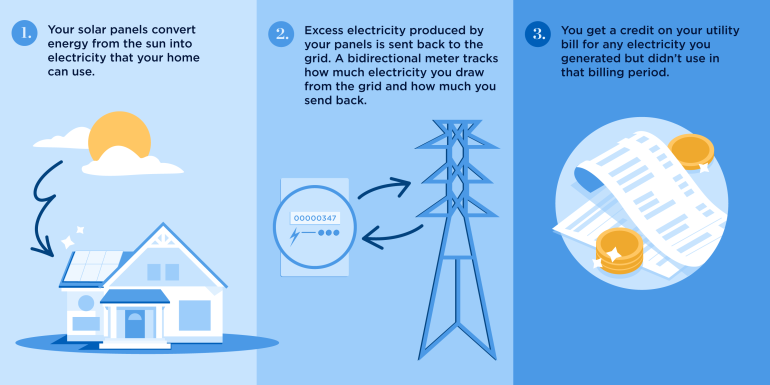Solar Net Metering: What to Know

Some or all of the mortgage lenders featured on our site are advertising partners of NerdWallet, but this does not influence our evaluations, lender star ratings or the order in which lenders are listed on the page. Our opinions are our own. Here is a list of our partners.
What is net metering?
Solar net metering, or NEM, is a billing mechanism that credits homeowners and businesses for excess solar electricity they generate and send to the power grid. The credits reduce the owner’s electric bills immediately or at a later time. Net metering, available in many states, makes solar more affordable.
How net metering works
Even though they produce their own power, solar panels are usually connected to the power grid. Net metering lets you use the power grid as a giant battery to store electricity you generate but don’t use right away.
When your panels aren’t producing as much electricity as you’re using — or aren’t producing at all, such as at night — you have to draw electricity from the grid. Your electric meter tracks this. When your solar panels send electricity to the grid, the meter spins backward to track that electricity as well. Depending on how NEM works in your area, you will be billed monthly or annually for your net energy usage, which is why it’s called net metering.
If your household is like most, you use less electricity during the middle of the day, when the sun is up and your solar system is generating the most energy. Without NEM — or a home solar battery — that excess electricity would be wasted, making your solar system less cost-effective. NEM lets you automatically send that electricity back to the grid and get a credit for the grid-based electricity that you use at night, on cloudy days and on shorter winter days.
If your system is sized to cover all your electricity needs, over the year the power you draw from the grid and the power you send back should even out.

» MORE: Pros and cons of solar panels
Net billing vs. net metering
Net billing isn’t the same as net metering.
Under net metering, you sell solar-generated electricity to the grid at the retail rate.
Under net billing, you sell your excess energy to the grid at a below-market rate. This lower rate can be the wholesale rate for electricity, or it can be based on a calculated value of the electricity at the moment it’s sent to the grid. This is also known as the “avoided cost” rate because it reflects the costs the utility avoids by buying power from you instead of producing that power itself or purchasing it elsewhere.
For example, under net billing, the value of electricity you send to the grid during the middle of a spring day is relatively low because there’s already so much solar on the grid at that time and energy demand is relatively low. That means you’ll get a much smaller credit for your excess solar than you would under net metering.
How buy-all, sell-all works
A few states offer a “buy-all, sell-all” system in which all of your solar-generated electricity goes to the grid in exchange for billing credits. Then, using a separate electric meter, you buy all your electricity from the utility. This system is rare, says Autumn Proudlove, associate director of policy and markets at the North Carolina Clean Energy Technology Center, and it may be optional.
» MORE: How long do solar panels last?
How much can you save on your electric bills with net metering?
Depending on how your state runs its net metering program, your savings can be significant. If you have high electric bills and enough solar panels to match your electricity use over the year, you could pay almost nothing for your electricity.
Most utilities charge a fee for building and maintaining the electric grid, so you’re unlikely to get your bill to zero with solar unless your system generates more electricity than you use.
These factors affect how much you’ll save on your electric bills:
Whether net metering is credited at the retail rate, i.e., whether the utility pays you the retail rate for power you supply to it.
How much electricity you use compared to how much your system generates.
Electricity rates, including rate structures and fixed costs.
Because state net metering policies are becoming less favorable to solar customers in many states, if your state currently has a good net metering program you’re likely to save more by going solar now. States that change their programs often exempt existing customers who had their solar installed under a previous program, as California did in 2023.
» MORE: How solar leasing works
Which states have net metering?
Most states have some kind of net metering or net billing program. Many of the states that don’t have net metering or net billing have either voluntary net metering or some other form of crediting or billing system for solar sent back to the grid. As of November 2023, 34 states, Washington, D.C., and a few U.S. territories had a mandatory net metering policy, according to the North Carolina Clean Energy Technology Center.
For the latest in your state, refer to the Database of State Incentives for Renewables & Efficiency (DSIRE).
National net metering trends
“The biggest trend we’ve been seeing is states considering or starting to move away from traditional retail rate net metering, where the customer receives a 1-to-1 credit for energy that they don’t use bill,” Proudlove says. Most states are moving toward a net billing model, Proudlove adds.
“In general, the direction has been toward reducing those credit rates. States are taking different approaches to this, so we see a lot of different designs all across the country,” Proudlove says, adding that most common is a move from monthly 1-to-1 netting to a real-time netting credited at a separate rate from the retail rate. “Most commonly, that rate is being set more toward a wholesale rate or an avoided-cost rate,” Proudlove adds.
The net billing tariff in California, implemented in April 2023, slashed the credit by about 75%, lengthening the expected payback time for an average California residential solar installation.
North Carolina, Arizona, Idaho and Arkansas have also lowered net metering credits,,,.
Hawaii, Nevada (which halted net metering but later reinstated it) and Indiana have restricted their net metering programs,,.
There are a few exceptions to the national trend. Massachusetts and Puerto Rico expanded their net metering programs in 2024, and in 2023 Florida’s governor vetoed a cut to net metering,,.
Net metering vs. solar batteries
Solar batteries can be a substitute for net metering. Instead of sending excess daytime power back to the grid at a low rate, solar panels send the excess power to a battery for later use.
In states that reduce net metering credits, solar battery adoption may increase, aided by the 30% federal tax credit now available for batteries. Some local incentives also exist.
“We’re seeing more states look to adopt incentives for storage, offering some kind of rebate or grant for customers to help offset that cost,” Proudlove says.
Many net metering programs are getting more granular with the credit rate and more complex in their policy design. This makes it more difficult to determine what your solar savings will be. In the ever-changing net metering landscape, it’s especially crucial to learn about the programs in your state before determining whether solar makes sense for you.


